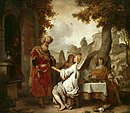Gerbrand van den Eeckhout

Gerbrand van den Eeckhout (19 August 1621 – 29 September 1674
Biography
Gerbrand was born in
Arnold Houbraken records Van den Eeckhout was a pupil of Rembrandt. A fellow pupil to Ferdinand Bol, Nicolaes Maes and Govert Flinck, but regarded as inferior to them in skill and experience; he soon assumed Rembrandt's manner with such success that his pictures were confused with those of his master.[4]
Eeckhout does not merely copy the subjects; he also takes the shapes, the figures, the
Eeckhout matriculated early in the
Eeckhout, unmarried, was also appreciated as art connoisseur, and dealing with poets and scientists. At the end of his life he was living with his sister-in-law, a widow, on Herengracht, at a very prestigious part of the canal. He died in Amsterdam.
Works
- The Continence of Scipio, Rijksmuseum Amsterdam
- Isaac Blessing Jacob, in the Metropolitan Museum of Art
- Resurrection of Jairus' daughter, in the Gemäldegalerie, Berlin
- Presentation in the Temple, in the Dresden gallery
- Presentation in the Temple, at Berlin
- Giving a Tenth, at Museum of Yugoslav History in Belgrade
- Tobit with the Angel, at Brunswick
- Woman taken in Adultery, at Amsterdam
- Anna presenting her Son to the High Priest, in the Louvre
- Epiphany, at Turin
- Circumcision, at Kassel
- A likeness of a lady at a dressingtable with a string of beads, at Vienna
- Sportsman with Hounds, in the Van der Hoo gallery (?)
- Group of Children with Goats in the Hermitage
- Vision of Cornelius the Centurion, at The Walters Art Museum
-
Scholar with His Books
-
Vision of Cornelius the Centurion (1664), Walters Art Museum
-
Abraham and the Three Angels (1656), Hermitage Museum
-
Anna presenting her son Samuel to the priest Eli (circa 1665), Louvre
-
Juno, Jupiter and Io (1672)
-
Joseph and his brothers (1657) Skokloster Castle
References
- ^ City Archive Amsterdam
- ^ Liedtke, W. (2007) Dutch Paintings in The Metropolitan Museum of Art, p. 185.
- ISBN 9780300208047.
- ^ a b c Chisholm 1911.
- ^ RKD
Attribution:
- This article incorporates text from a publication now in the public domain: Chisholm, Hugh, ed. (1911). "Eeckhout, Gerbrand van den". Encyclopædia Britannica. Vol. 9 (11th ed.). Cambridge University Press. p. 8.
External links
- Eeckhout the Rijksmuseum
- Works and literature at PubHist
- Vermeer and The Delft School, an exhibition catalog from The Metropolitan Museum of Art (fully available online as PDF), which has material on Gerbrand van den Eeckhout
- Dutch and Flemish paintings from the Hermitage, an exhibition catalog from The Metropolitan Museum of Art (fully available online as PDF), which contains material on Gerbrand van den Eeckhout (cat. no. 8)






